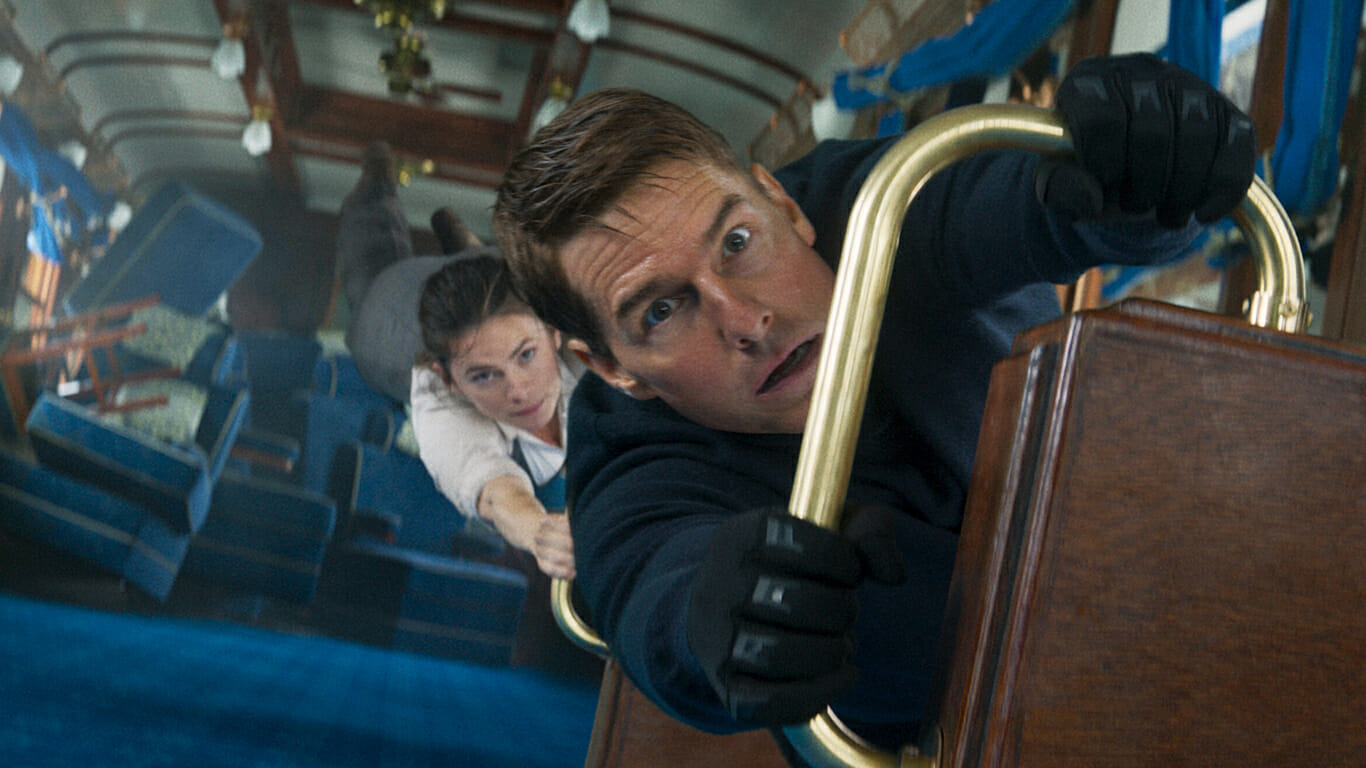I love the Mission: Impossibles for what they are now—glossy, winking Tom Cruise vehicles for his superhuman practical stunt work—but it’s hard to deny something’s been lost over the years. As the sequels progressively tilt the espionage-to-action ratio, they lose the grounded stakes of a pawn trapped in a game. Ethan Hunt is now, as Rogue Nation put it, “the living manifestation of destiny,” a mythic counterbalance to clandestine evils. He’s not escaping the game; he’s playing it, transcending it, setting new rules and saving the world. Mission: Impossible – Dead Reckoning Part One (concise!) heightens the stakes yet again: Fallout ended with nuclear threat? Reckoning gets there in act one. The spy thrills of the first film seem almost quaint.
READ ALSO: Read all of Ryan Bordow’s movie reviews here
DEEPER DIVE: Here’s how Arizona film incentives could attract filmmakers
Thankfully, even with a front-loaded nuke, MI7 isn’t too much too fast. Writer/director Christopher McQuarrie—helming his third successive film in the series—is a master of escalation, and Reckoning strikes his finest pace yet. He sublimates the first-act nuke into one of many moving pieces in an expert series of crosscuts: at the Abu Dhabi International Airport, right-hand man Benji (Simon Pegg) disarms the bomb in baggage handling while Ethan (you know who) tails a mark upstairs. Also, a team of intelligence agents is after Ethan, so he’s bobbing and weaving around them; also also, an unknown thief-for-hire (Hayley Atwell, a delight) is after Ethan’s mark too, forcing him to bribe and keep an eye on her; and on top of that, an eerie new villain is following from the shadows, all while Benji and Ethan (and Ving Rhames’ Luther, of course) solve riddles over comms to defuse a puzzle-box bomb. There’s so much going on in this sequence—cats and mice switching roles, heart-on-sleeve character moments and new pieces hitting the chessboard—but it’s cut together so legibly, so mindful of rhythm and tempo, that the presence of a nuke doesn’t dominate the mood. The scene has fifty wheels, but it moves at a steady, early rate, very much a first-act pregame. The control over the spectacle is incredible.
And it is mostly spectacle. The narrative’s threadbare—another McGuffin, another global threat, some hollow gesturing at an origin story—but that’s all it really needs to be. The joys of Mission: Impossible loop back to early cinema, when the incipient wonder of the moving image was the medium’s main draw. Historians call that “the cinema of attractions”: story was secondary to the sheer marvel of seeing a world inside the screen. A century plus of advancing the medium has diluted the novelty of the moving image, but McQuarrie’s missions make movies feel young again. I didn’t care that I didn’t care about the context of each set piece, and it mattered not that I knew what was coming (the scene where Cruise base jumps off a cliff from the seat of a speeding motorcycle has been over-marketed to ubiquity)—I was still floored by how the stunts were arranged onscreen. Whether it’s soaring drone footage with a God’s-eye view of His bravest creation (you know who) or a genius gimbal construction sticking close to Cruise as he plummets, I couldn’t believe how I was seeing, narrative immersion be damned. I may have felt like an observer, detached, watching from the gallery—but I didn’t care. Reckoning trades suspension of disbelief for the straight-up unbelievable.
And the vibe of early cinema doesn’t stop at the attractions. In two of its most elaborately staged set pieces—a car chase in Rome and a tense, unscored train crash, the latter of which was done by sending a real train car off a ravine—the film recalls the antics of Buster Keaton classics (as well as Battleship Potemkin, but who hasn’t referenced that). There’s so much physical comedy in the camera placement, body language, and ideas themselves. Hunt steering a car from the passenger seat while handcuffed to the “driver” is loopy, swiveling fun (the car must’ve been crawling with cameras; the coverage of Cruise driving is spectacular), and a big car chasing a little car in high- and wide-angle shots plays like slapstick with figurines. The Mission: Impossibles have always been funny, but they’d never married humor with action this well. You’ll fall off the edge of your seat laughing.
The script aims for humor and gets there often enough—the series knows how to wink at its reputation—but dialogue can dip towards cold and formulaic. The exposition, of which there is a lot, is dry, and many of the dramatic lines, which want to walk a line between camp and cool—Ethan and co. finish each other’s sentences with playful Homeric gravitas—never fully register as either. The syntax isn’t a spectacle, which is a shame since basically everything else is. The closest the script comes to writerly exhibition is a rival agent calling Hunt “a mind-reading, shape-shifting incarnation of chaos,” a splendid update to “living manifestation of destiny.”
And there’s something to that new description. For the first time in years, Dead Reckoning finds Ethan near his initial position: a pawn trapped in a game. Granted, he’s a pawn that can move ten squares at once and tunnel under the board, but he’s a pawn nonetheless. The film’s villain is “the Entity,” a sentient AI that has infiltrated the world’s intelligence agencies and plans to mold to its whims what’s passed down to the populace as truth. It’s not an original concept—it is, almost exactly, the plot of Metal Gear Solid 2: Sons of Liberty, a 2004 video game—but it enlivens the film in interesting ways. For one, the AI has decided in its intrinite wisdom (that’s infinite internet wisdom) that Ethan is its main obstacle, so it elects to target Ethan’s friends—something it’s very good at, running endless simulations and all. Suddenly the stakes are a little more personal than global nuclear fallout. In addition, the world’s intelligence agencies are bent on controlling the AI, putting Ethan in more direct conflict with them. This gets existential for Hunt: how long can he fight the system from inside it? The IMF has long relied on other agencies for information and work. Will cutting through the intelligence net imperil his friends just as much? By personalizing the stakes, trading global collapse for information control, and introducing a villain that can stay a step ahead of Ethan, Reckoning feels like a truer spy thriller than any of the sequels. Ethan isn’t destiny, calling all the shots; now he’s chaos, railing against the walls closing in around him.
Ostensibly inspired by this shade of the first film, McQuarrie evokes the aesthetics of De Palma’s original. There are copious Dutch angles and jump cuts, stirring up conversations with uneasy panache. And I doubt this was intentional, but the design of the Entity—which appears on screens as an evil blue swirl and growls with chiptune menace—is charmingly anachronistic, like it was imagined in ’96 with the first one’s tech. Henry Czerny even returns as Kittridge for the first time since the original. There’s a real sense of closing the circle here. There may be films planned past the Reckoning duology, but Part One makes a great argument for a finale (even if only of sorts).
I didn’t even mind that it’s only a Part One. This thing is so inspired, so thoughtfully paced and structured, that it feels decisive and complete despite its open questions. In an age of half-conceived part ones, it feels like a minor miracle, pushing it over the edge to become the best Mission: Impossible. Maybe. Four or five of these movies are really damn good.
★★★★½ (4.5/5)




